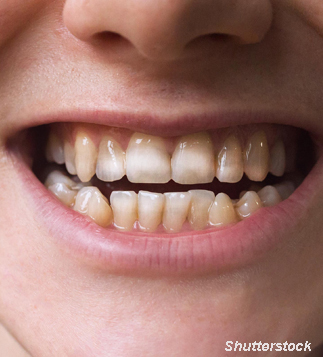Distinctive Discolourization Indicative of Celiac Disease?
 Those spots may seem insignificant, but health experts say they could be a sign of a severe digestive disorder.
Those spots may seem insignificant, but health experts say they could be a sign of a severe digestive disorder.
Jessica Migala, Reader’s Digest 1
Your mouth is a window into your health, according to the American Dental Association. Two examples are links between gum disease and heart troubles, and poor oral health as a potential early indicator of Alzheimer’s. Now, experts say that off-colored spots on your teeth may actually be a sign of celiac disease.
Celiac, an autoimmune disorder, affects 1 percent of people worldwide, and 2.5 million Americans are undiagnosed, according to the Celiac Disease Foundation. Celiac sufferers suffer an immune reaction to gluten, a protein found in wheat, rye, and barley. Over time, that immune response can damage digestive structures in the small intestine, and this interferes with your body’s ability to absorb vital nutrients—such as calcium.
And missing out on calcium can cause dental enamel hypoplasia—the medical term for white, yellow, or brown spots on your teeth. “It can be seen in as many as 40 to 50 percent of new pediatric celiac patients, compared to six percent of the healthy population,” says Hilary Jericho, MD, a specialist in pediatric gastroenterology at the University of Chicago. Experts don’t agree on the exact reason why, but the spots may occur when the body fails to absorb the calcium needed for strong teeth, she explains.
“For some people with celiac disease, a dental visit, rather than a trip to the gastroenterologist, was the first step toward discovering their condition,” says the National Institute of Diabetes and Digestive and Kidney Disease (NIDDK). When it comes to white spots, they’re most often seen in kids since these nutrient deficiencies affect the way tooth enamel forms, but it may also affect adults who are undiagnosed, adds Dr. Jericho.
Of course, the spot may not be a sign of celiac at all; however, your doctor should be concerned if those spots are symmetrical and scattered across most of your teeth, says Dr. Jericho. Recurrent canker sores, a red, smooth, shiny tongue, or dry mouth can also point to celiac, according to the NIDDK.
In addition to dental woes, patients will likely experience other body-wide symptoms, such as diarrhea or bloating, heartburn, fatigue, and joint pain. If your child has the spots and is falling behind on growth charts, appears pale, or is suffering from GI symptoms, says Dr. Jericho, talk to your doctor about celiac.
Just remember that unless you’ve been diagnosed with celiac, you shouldn’t go gluten-free—there are real health risks. From wheat allergy to Crohn’s, these are the conditions that are easily mistaken for celiac disease.
SEE ALSO:













